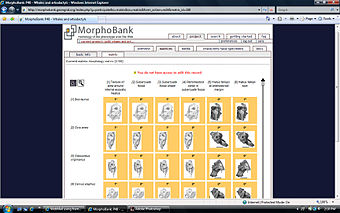- Morphobank
-
MorphoBank is a Web application for collaborative evolutionary research, specifically phylogenetic systematics or cladistics, on the phenotype. Historically, scientists conducting research on phylogenetic systematics have worked individually or in small groups employing traditional single-user software applications such as MacClade,[1] Mesquite [2] and Nexus Data Editor.[3] As the hypotheses under study have grown more complex, large research teams have assembled to tackle the problem of discovering the tree of life for the estimated 4-100 million living species(Wilson 2003, pp. 77–80) and the many thousands more extinct species known from fossils. Because the phenotype is fundamentally visual, as phenotype-based phylogentic studies increase in size it becomes important that observations be backed up by labeled images. Traditional desktop software applications currently in wide use do not provide robust support for team-based research or for image manipulation and storage.
Contents
Advantages
Large phylogenetics research teams require simultaneous access by each member of the team to a single and secure copy of the team's data during the research project. This single copy of the data also changes with great frequency during the data collection phase. Images that can be very helpful for documenting homology statements must be displayed, labeled and shared as homology statements develop. This cannot be accomplished elegantly with a desktop software package alone because in a desktop environment each collaborator is working on his own private copy of project data. Changes made by one participant cannot automatically propagate to others, preventing collaborators from seeing each others' data edits until they are manually (and due to the effort involved, often only periodically) merged into a single "true" dataset. In all but the smallest and most disciplined of teams, file version control and the reconciliation of changes made on multiple copies of the data emerge quickly as significant drags on productivity.
MorphoBank is an attempt to address these issues by leveraging the ubiquity of the web and modern web-based application techniques, including Ajax, web service layers, and rich internet applications to provide a full-featured, net-accessible collaborative workspace for phylogenetic research. In particular, MorphoBank makes it easy to:
- Share all kinds of data with geographically separated team members, including taxonomy, character and specimen data, media (including images, video and audio), phylogenetic matrices (including data in the widely used [Nexus_file NEXUS] format) and other data such as documents and genetic sequences.
- Label high-resolution images using a web-based image annotation application.
- Collaboratively edit project data such as phylogenetic matrices using a built-in web-based matrix editor. The editor allows the linking of labeled images to individual cells of a matrix.
- Manage access to project data. Access ranges from full-access for team members to anonymous read-only access for potential reviewers.
- Publish completed project data on the web in support of a published paper with a persistent URL.
These tasks are difficult or impossible in most existing software applications.
History
MorphoBank grew out of the need for a research platform with robust support for annotated imagery. In 2001 the National Science Foundation sponsored a workshop ,[4] at the American Museum of Natural History in New York to develop the outlines of a web-based system for collaborative, media-rich research tool. An application prototype presented at the workshop was later refined with feedback from the workshop and became MorphoBank version 1.0. A grant from the US National Oceanic and Atmospheric Administration funded further revisions resulting in version 2.0, released in 2005. Current support from the NSF is funding current feature enhancements to MorphoBank. The current version is 2.7.
The San Diego Supercomputer Center provides technical and hosting resources to the MorphoBank project.
Usage
An increasing volume of systematics data is "born digital" and MorphoBank is well suited to handle this type of material. Usage has steadily increased. As of August 24, 2007, 62 active research projects were hosted by MorphoBank, as well as 6 completed (and published) projects. Most recently, the MorphoBank software has been used to assemble the phylogenetic paper for a recent major discovery in fossil bat evolution. [5]
Ongoing projects include clade-scale reconstruction projects such as those sponsored by the Assembling the Tree of Life initiative. MorphoBank is well-suited to such projects because of its tools for merging taxonomic, character and matrix-based data, as well as its collaborative features.[6] Projects including large scale matrices [7] as well as projects with taxonomic and imagery only[8] have been developed and published on MorphoBank recently.
References
- ^ MacClade, a computer program for phylogenetic analysis, David R. Maddison and Wayne P. Maddison.
- ^ Mesquite, A modular system for evolutionary analysis, Wayne P. Maddison
- ^ Nexus Data Editor A program to edit NEXUS format data files, Roderick D. M. Page
- ^ MorphoBank workshop report, November 10-11, 2001
- ^ MorphoBank project list page retrieved on August 24, 2007
- ^ The supermatrix approach to systematics, Alan de Queiroz and John Gatesy, TRENDS in Ecology and Evolution, Vol.22 No.1, 2006.
- ^ Cretaceous eutherians and Laurasian origin for placental mammals near the K/T boundary. J. R. Wible, G. W. Rougier, M. J. Novacek & R. J. Asher. Nature 447, 1003-1006 (21 June 2007)
- ^ "Revision of the fishfly genus Ctenochauliodes Weele (Megaloptera, Corydalidae)". Liu, Xingyue and Yang, Ding. Zoologica Scripta 35, 473-490, 2006.
Citations
Wilson, E. O. (2003), "The encyclopedia of life", TREE 18: 77–80.
External links
- MorphoBank home page
- Modernizing the Tree of Life, Science, 10 June 2003, 300: 1692-1697. Article discussing efforts of projects including MorphoBank to simplify and speed up the assessment of biodiversity.
- "Morphology: The Shape of Things to Come", Paul D. Thacker, BioScience, June 2003, Vol. 53 No. 6, 544. A report on contemporary initiatives in morphological research, including MorphoBank.
Categories:- Web applications
- Bioinformatics software
Wikimedia Foundation. 2010.

